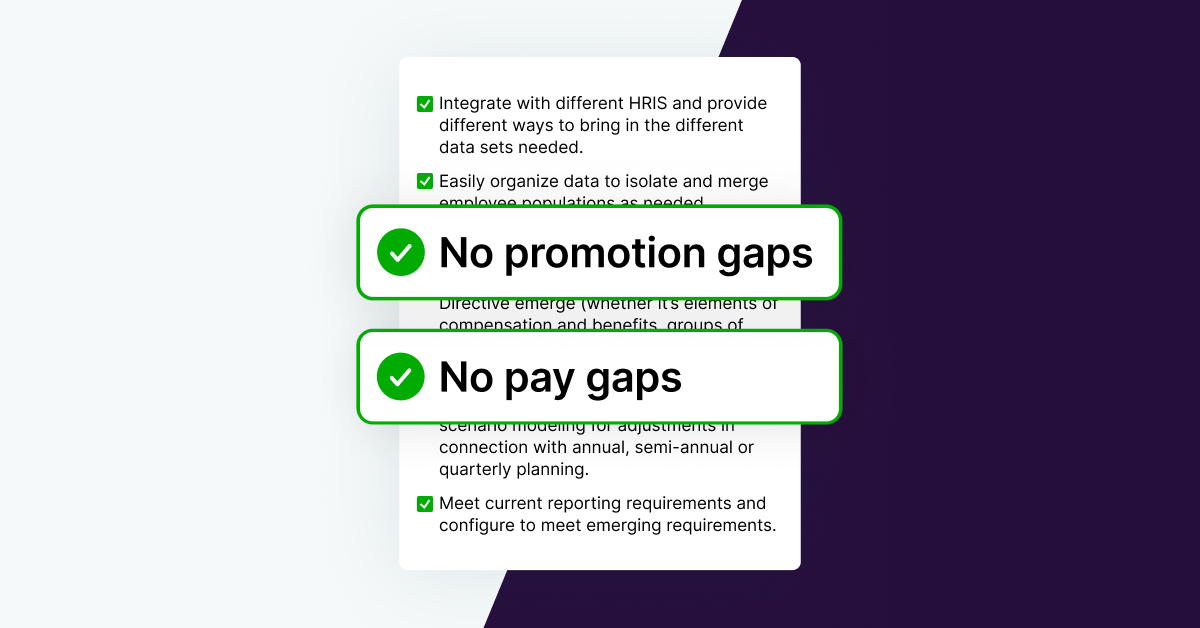The recent release of the Netflix documentary Fair Play (based on Eve Rodsky’s book by the same name) shines a spotlight on the “invisible labor” women shoulder in the household. On average, women spend two extra hours per day of unpaid domestic labor at home compared to men — added up over a year, that’s more than a full month of extra chores, errands, and family management such as childcare, cleaning, grocery shopping, cooking, laundry, household planning, calendar scheduling, and everything else required for a home and family to function. It’s no wonder that in nearly every country men have more leisure time each day than women.
However, the burden of invisible labor doesn’t end when women walk into the office or log onto their computer to start a day of remote work. Invisible labor also follows women into the workplace — with detrimental consequences for their careers and for workplace equity.
Key terms
Before we discuss the impact of invisible labor in the workplace, let’s define a few key terms.
Invisible labor: The term “invisible labor” (also sometimes called “hidden work”) owes its roots to a 1987 journal article by American sociologist Arlene Kaplan Daniels. She defined “invisible work” as unpaid work performed in the private sphere outside of the market economy — and therefore devalued in both status and validation. Invisible labor exists due to the assumption that women are just “naturally” better at caregiving and nurturing and, because this type of work is “intrinsic” to women, these efforts do not require reward. However, household work is consistently found to be divided more equitably and viewed as more fair in LGBTQ+ relationships compared to cisgender, heterosexual relationships, likely due in part to the lack of gendered assumptions about default housework responsibilities.
Mental load: An important component of invisible labor is the mental load, or cognitive work, that comes with anticipating, monitoring, and managing all of the needs, resources, and schedules of the family. Keeping track of pantry stocks, grocery lists, birthdays, appointments, and homework deadlines, as well as planning and coordinating schedules, vacations, and social events is mentally exhausting. There’s also the burden of having to give reminders and requests for help to one’s partner, rather than them proactively taking on any of the planning. Multiple studies have found that men believe that they share equally in housework and are satisfied with how household chores are divided, but that their female partners disagree. Partners may think they’re being supportive by saying “just let me know how I can help,” but that puts all the onus of project management back on the other partner who must keep brain space dedicated to “keeping track of everything.”
Emotion work vs. emotional labor: Emotion work is the interpersonal effort of maintaining and strengthening social connections and providing support to one’s network of family and friends. Also known as “kinkeeping,” it can encompass being the one to track birthdays and send cards, organize holiday events, schedule Zoom calls with distant relatives, and so on — all of which primarily falls to women. This type of invisible labor is often erroneously called emotional labor; however, the textbook definition of emotional labor is specific to the fatigue of “regulating or managing emotional expressions with others as part of one’s professional work role.” For example, emotional labor includes being required to provide service “with a smile” when interacting with rude clients, or having to hide inner emotions when faced with sexist or racist micro-aggressions from customers or coworkers.
What does invisible labor in the workplace look like?
In the workplace, women spend more time on “non-promotable tasks” than men, which is unpaid work related to social or administrative “office housekeeping.” These types of activities are vital to maintaining company culture and strengthening team connections, but are not valued as strategic — and therefore come with little to no recognition, appreciation, reward, or career advantage. Examples include being expected to:
- Organize team events and office parties
- Collect money and send cards, flowers, or gifts to colleagues facing situations such as illness or loss
- Remember and acknowledge team member birthdays and work anniversaries
- Perform office “housework” like tidying up conference rooms after meetings or making coffee, or in remote scenarios, being the one to take meeting notes and send out action items
- Provide emotional support to colleagues such as comforting or soothing
- Welcome or mentor new employees
- Lead and serve in employee resource groups (ERGs) and DE&I committees
- Be nurturing, approachable, and warm
The following quote by one of the authors of the 2021 Women in Workplace Report by LeanIn.org and McKinsey & Company is eye-opening. In a Harvard Business Review article about the report, the author shares that, “At all levels of management, women showed up as better leaders, more consistently supporting employees and championing DEI. Compared to men in similar roles, women managers invest more in helping employees navigate work-life challenges, ensuring workloads are manageable, and providing emotional support. Women managers are also more likely to act as allies to women of color by speaking out against bias and advocating for opportunities for them. Finally, women leaders are also more likely than men to spend time on DEI work outside of their formal job responsibilities, such as leading or participating in employee resource groups (ERGs) and serving on DEI committees.”

The reason invisible labor in the workplace falls so heavily on women seems to stem from gendered assumptions, expectations, and social conditioning. In a study by Harvard Business Review, in mixed-sex groups, women received 44% more requests to volunteer for non-promotable tasks than men, regardless of the gender of the manager making the request. Women were also more likely to accept a request to volunteer: women said “yes” 76% of the time compared to men who accepted 51% of the time.
How invisible labor in the workplace impacts women
Spending time on work that isn’t valued
Most companies claim to value culture, and the work that supports it. In a global survey of CEOs and CFOs, more than 90% said culture is important at their organizations, 78% said culture is among the top five things that make their company valuable, and 92% said they believed improving their corporate culture would improve the value of the company.
Invisible labor in the workplace — helping team members feel connected and supported, keeping the office comfortable, helping to promote DE&I, and building a welcoming environment — is the work of maintaining and strengthening company culture. However, despite assertions that this work is important, most companies don’t value or recognize it in practice.
The 2021 Women in Workplace Report found that while 87% of companies say that managers’ work to support employee wellbeing is critical, only 25% formally recognize this work in performance evaluations. Similarly, while 70% of companies say that employee work to promote diversity, equity, and inclusion is very or extremely critical, only 24% formally recognize it.
One of the authors of the 2021 Women in Workplace Report describes how “When a woman manager provides team members with emotional support during a time of societal crises, it can be overlooked as ‘caretaking’ instead of being recognized as strong crisis management. When a Black woman manager hosts a panel on anti-racism in the wake of racial violence, she can be applauded for her ‘passion’ but not rewarded for her time, leadership, or DEI acumen.” Rather than getting credit for demonstrating leadership skills, this type of emotionally supportive, culture-building work is discounted because women are assumed to have a natural capacity for it.
Not receiving professional credit
Because invisible labor is devalued and under-appreciated in the corporate hierarchy, it is, by definition, thankless. It doesn’t come with networking benefits or opportunities for career advancement. At most, women who volunteer (or, as is often the case, are “volun-told”) for these activities receive a brief mention of thanks.
In this anecdote from HuffPost, the author shares how she spent over 50 hours coordinating a fundraiser event for the company on behalf of an executive sponsor. In return for all of that unpaid work (not to mention the accompanying stress, mental load, and energy toll), she received a two-second mention from her manager of, “Oh, and thank you to Kelli for coordinating this event.”
Getting penalized for not performing invisible labor
Further, more than simply not being rewarded for doing invisible labor, women can actually be penalized for not doing it. Because women are expected to serve as caregivers and perform office housework, this extra load becomes their baseline. If they refuse to perform work like tidying up after colleagues, they face penalties such as receiving worse performance evaluations, getting fewer recommendations for promotions, and being considered less likable by coworkers.
Even more unfairly, the opposite is true for men in the workplace. Men do less office housework than women, but when they do perform these chores, they have a higher likelihood of being recommended for promotions, raises, and bonuses. Men are rewarded for this work because they are seen as behaving altruistically by going “above and beyond” what is expected of them, whereas women doing this work are just doing the baseline of what is expected of them.
In addition, invisible labor creates consequences for women’s careers due to the sheer fact that when women spend their limited time, mental effort, and emotional energy on unpaid, non-promotable work, they are not using those resources for strategic work that will help advance their careers. As a New York Times article about office housework states, “The person taking diligent notes in the meeting almost never makes the killer point.”
As another example, women in higher ed spend more time on providing supportive services than men (such as women professors being more likely than men professors to have their office hours be used as “confessional time” to provide emotional support to students), which is not work that contributes to tenure or promotion. Further, spending time and energy on supportive work is actively detrimental because it leaves women professors with less time for research and publication — the work that does lead to advancement and prestige in academia.
Being at higher risk of burnout
Performing invisible labor in the workplace on top of paid work leads to fatigue, overwhelm, and burnout for women — especially since women then go home to provide more hours of domestic labor and care than men. Working women take on a “second shift” at home in which they spend more than one extra hour a day on housework compared to working men. It’s no surprise that women leaders are “more likely to be exhausted and chronically stressed at work, compared to men in similar roles.”
The 2021 Women in Workplace Report found that 40% of women managing teams have considered leaving the workforce or downshifting their careers. The COVID-19 pandemic exacerbated the overwhelm that women are feeling, as women disproportionately took on the extra load of childcare caused by school and childcare closures and the shift to remote education. Women spent 7.7 more hours a week than men on unpaid childcare in 2020. All of this contributed to a “shecession” that erased several areas of progress towards workplace equity for women.
Earning less money over a lifetime
There’s a through line from invisible labor to the pay gap: women who spend time on non-promotable tasks are not spending time on promotable tasks, contributing to slower career advancement and fewer opportunities. And opportunity inequity is a major contributor to the median pay gap.
When unaddressed, pay inequities and pay gaps compound over time, leading to disparities in lifetime earnings and wealth accumulation. According to the National Women’s Law Center research on the lifetime wage gap, lifetime earning losses for women are $406,280 over the course of a 40-year career, while Black women lose $964,400.
Lifetime earning losses for women are $406,280 over the course of a 40-year career, and nearly a million ($964,400) for Black women.
– National Women’s Law Center
A disproportionate impact
Invisible labor doesn’t impact all women equally — it is disproportionately felt by women of color, LGBTQ+ women, and women with disabilities. The 2021 Women in Workplace Report found that at the manager level and above, Black women, LGBTQ+ women, and women with disabilities are “up to twice as likely as women overall to spend a substantial amount of time promoting DEI.”
While Black women face the most obstacles to career advancement and the most micro-aggressions in the workplace, they are also “more likely than any other group of employees, including men of color and women of other races and ethnicities, to spend a substantial amount of time on DEI work that falls outside their formal job responsibilities.”
The big picture of gender equity in the workplace
Invisible labor in the workplace is taking a toll on women’s careers. Companies may say they value employee contributions to company culture — and they certainly reap the benefits of it — but until this type of work is equitably distributed, viewed as valuable, and formally recognized, women will continue to bear the burden.
As companies prioritize progress towards pay equity and opportunity equity, they must dig into root causes of their pay gap — one of which is the disproportionate expectation on women to perform invisible labor in the workplace. It’s also important for companies to expand their workplace equity analyses to include more factors that can negatively impact equitable employment outcomes for women, such as caregiving. It seems that leading companies are realizing this and starting to collect and analyze more employee data — in fact, the 2023 Workplace Equity Trends Report found that caregiving status is an emerging identity group that 12% of companies are now tracking.
Read the full report at the link below to learn more about how HR, Compensation, and DE&I leaders are approaching workplace equity initiatives, analyses, and communications next year.



